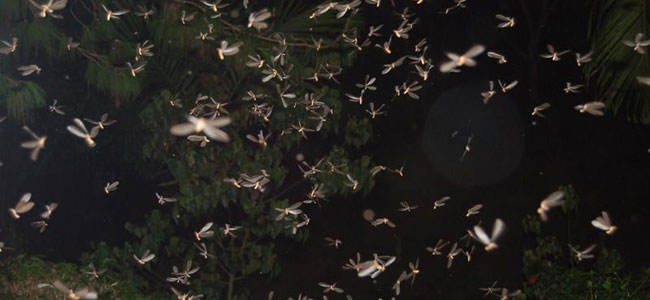Reasons Why Termites Swarm?
By Chris Williams on June 22, 2013.

Termite swarms or flights are a form of reproduction, although the termites don’t mate while in flight as some insects do. Winged termites are the potential kings and queens of new termite colonies. The swarms are also a way of dispersing termites to new areas, although they are relatively weak fliers and usually don’t go far. Swarming also helps add genetic diversity to the termite species since individuals from different colonies can intermix and mate as a result of swarming.
The number of swarmers produced by any one colony varies with the species and the age and condition of the colony. A mature termite colony will produce winged swarmers every year, and tends to produce more swarmers as the colony grows. When environmental conditions are right and the winged forms inside the colony are fully developed, subterranean termite workers will make an opening to the outside for the winged swarmers to emerge from the ground colony. In a given location, thousands of swarmers can emerge from a number of different colonies at the same time.
Wings are a Temporary Thing
Once winged termites leave the colony, they usually flutter close to the ground. The direction and the distance of their flights are strongly influenced by wind. Air currents can lift termites to high altitudes and they sometimes are carried to the tops of tall buildings. But most swarmers tumble to the ground after only a short flight. Their wings are then no longer necessary and break off easily near the base, which doesn’t hurt the termites. Large numbers of cast-off wings are commonly found where there has been a termite swarm.
Swarming is Hazardous
This period when termites are leaving the nests, flying, and seeking a mate and a new nesting site is extremely dangerous for them. They are preyed upon heavily by birds, lizards, frogs, and other animals, as well as by spiders, ants, and other predaceous insects. Swarmers are subject to drying out, heat, and cold, and many end up trapped on the surface of water. Only a very small percentage of swarmers survive long enough to start new colonies.
The surviving females release a pheromone to attract a future king. The pair search for a suitable site for the establishment of their new nest. They will usually enter the soil under or near a piece of wood on the surface. They use their jaws (mandibles) to excavate a small chamber where mating occurs. The pair live together for life. The first eggs are laid one to several weeks after mating. As the hatching nymphs mature, they assume their role as workers and begin to care for the queen and king and then new eggs and nymphs. And thus begins a new subterranean termite colony.
Photo credit: Ganesh-B.R.Hills / Foter.com / CC BY